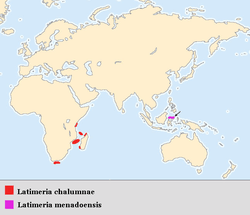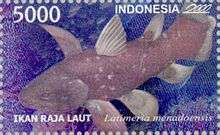Indonesian coelacanth
| Indonesian coelacanth | |
|---|---|
 | |
| A preserved specimen of Latimeria menadoensis, displayed in Tokyo Sea Life Park (Kasai Rinkai Suizokuen), Japan | |
| Scientific classification | |
| Kingdom: | Animalia |
| Phylum: | Chordata |
| Class: | Sarcopterygii |
| Order: | Coelacanthiformes |
| Family: | Latimeriidae |
| Genus: | Latimeria |
| Species: | L. menadoensis |
| Binomial name | |
| Latimeria menadoensis Pouyaud, Wirjoatmodjo, Rachmatika, Tjakrawidjaja, Hadiaty & Hadie, 1999 | |
 | |
| L. menadoensis range in violet | |
The Indonesian coelacanth (Latimeria menadoensis, Indonesian: raja laut) is one of two living species of coelacanth, identifiable by its brown color. It is listed as vulnerable by the IUCN.[1] The other species, L. chalumnae (West Indian Ocean coelacanth) is listed as critically endangered.[2]
Discovery

On September 18, 1997, Arnaz and Mark Erdmann, traveling in Indonesia on their honeymoon, saw a strange fish enter the market at Manado Tua, on the island of Sulawesi.[3] Mark Erdmann thought it was a gombessa (Comoro coelacanth), although it was brown, not blue. Erdmann took only a few photographs of the fish before it was sold. After confirming that the discovery was unique, Erdmann returned to Sulawesi in November, 1997 interviewing fishermen to look for further examples.[4][5] In July 1998, a fisherman Om Lameh Sonatham caught a second Indonesian specimen, 1.2 m in length and weighing 29 kg on July 30, 1998 and handed the fish to Erdmann.[6] The fish was barely alive, but it lived for six hours, allowing Erdmann to photographically document its coloration, fin movements and general behavior. The specimen was preserved and donated to the Museum Zoologicum Bogoriense (MZB), part of the Indonesian Institute of Sciences (LIPI).[3]
DNA testing revealed that this specimen differed genetically from the Comorian population.[7][8] Superficially, the Indonesian coelacanth, locally called raja laut ("King of the Sea"), appears to be the same as those found in the Comoros except that the background coloration of the skin is brownish-gray rather than bluish. This fish was described in a 1999 issue of Comptes Rendus de l'Académie des sciences Paris by Pouyaud et al. It was given the scientific name Latimeria menadoensis.[9].
In 2000, another group of researchers claimed that they had known the species earlier from the same region; the journal editors discovered that the photograph they sent to illustrate their publication was a coarse collage of the one published by the discoverer in 1998, so that this claim was not published.[10]
In 2005, a molecular study estimated the divergence time between the two coelacanth species to be 40–30 mya.[11]
On November 5, 2014 a fisherman found a specimen of this species in his net. It was the seventh Indonesian coelacanth found in Indonesian waters since 1998.[12]
Habitat
Teams of researchers using submersibles have recorded live sightings of the fish in the waters of Manadua Tua and Talise islands in the Sulawesi as well as in the waters of Biak in Papua.[13][14] These areas share similar steep rocky topography full of caves, which are the habitat of the fish. These coelacanths live in deep waters of around 150 metres or more, at a temperature between 14 and 18 degrees Celsius.[13]
References
- 1 2 Erdmann, M. (2008). "Latimeria menadoensis". The IUCN Red List of Threatened Species. IUCN. 2008: e.T135484A4129545. doi:10.2305/IUCN.UK.2008.RLTS.T135484A4129545.en. Retrieved 11 January 2018.
- ↑ Musick, J. A. (2000). "Latimeria chalumnae". The IUCN Red List of Threatened Species. IUCN. 2000: e.T11375A3274618. doi:10.2305/IUCN.UK.2000.RLTS.T11375A3274618.en. Retrieved 11 January 2018.
- 1 2 Jewett, Susan L., "On the Trail of the Coelacanth, a Living Fossil", The Washington Post, 1998-11-11, Retrieved on 2007-06-19.
- ↑ Gee, Henry (1 October 1998). "Coelacanth discovery in Indonesia". Nature. doi:10.1038/news981001-1.
- ↑ "The Discovery". University of California Museum of Paleontology.
- ↑ Nelson, Joseph S. (2006). Fishes of the World. John Wiley & Sons, Inc. ISBN 0-471-25031-7
- ↑ Erdmann, Mark V. (April 1999). "An Account of the First Living Coelacanth known to Scientists from Indonesian Waters". Environmental Biology of Fishes. Springer Netherlands. 54 (#4): 439–443. doi:10.1023/A:1007584227315. 0378-1909 (Print) 1573-5133 (Online). Retrieved 2007-05-18.
- ↑ Holder, Mark T.; Mark V. Erdmann; Thomas P. Wilcox; Roy L. Caldwell & David M. Hillis (1999). "Two living species of coelacanths?". Proceedings of the National Academy of Sciences of the United States of America. 96 (22): 12616–12620. doi:10.1073/pnas.96.22.12616. PMC 23015. PMID 10535971.
- ↑ Pouyaud, L.; S. Wirjoatmodjo; I. Rachmatika; A. Tjakrawidjaja; R. Hadiaty & W. Hadie (1999). "Une nouvelle espèce de coelacanthe: preuves génétiques et morphologiques". Comptes Rendus de l'Académie des Sciences, Série III. 322 (4): 261–267. doi:10.1016/S0764-4469(99)80061-4. PMID 10216801.
- ↑ McCabe, H. & J. Wright (2000). "Tangled tale of a lost, stolen and disputed coelacanth". Nature. 406: 114. doi:10.1038/35018247.
- ↑ Inoue J. G.; M. Miya; B. Venkatesh; M. Nishida (2005). "The mitochondrial genome of Indonesian coelacanth Latimeria menadoensis (Sarcopterygii: Coelacanthiformes) and divergence time estimation between the two coelacanths". Gene. 349: 227–235. doi:10.1016/j.gene.2005.01.008. PMID 15777665.
- ↑ Gabriel Wahyu Titiyoga (November 15, 2014). "Another Pre-Historical Fish Caught in Sulawesi Water".
- 1 2 Augy Syaihailatua (March 30, 2015). "Hunting for living fossils in Indonesian waters". The Conversation.
- ↑ Rik Nulens, Lucy Scott and Marc Herbin (22 September 2011). "An updated inventory of all known specimens of the coelacanth, Latimeria spp" (PDF). Smithiana.
External links
- Indonesian coelacanth on YouTube


